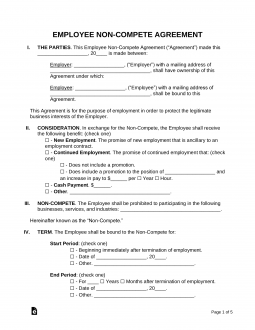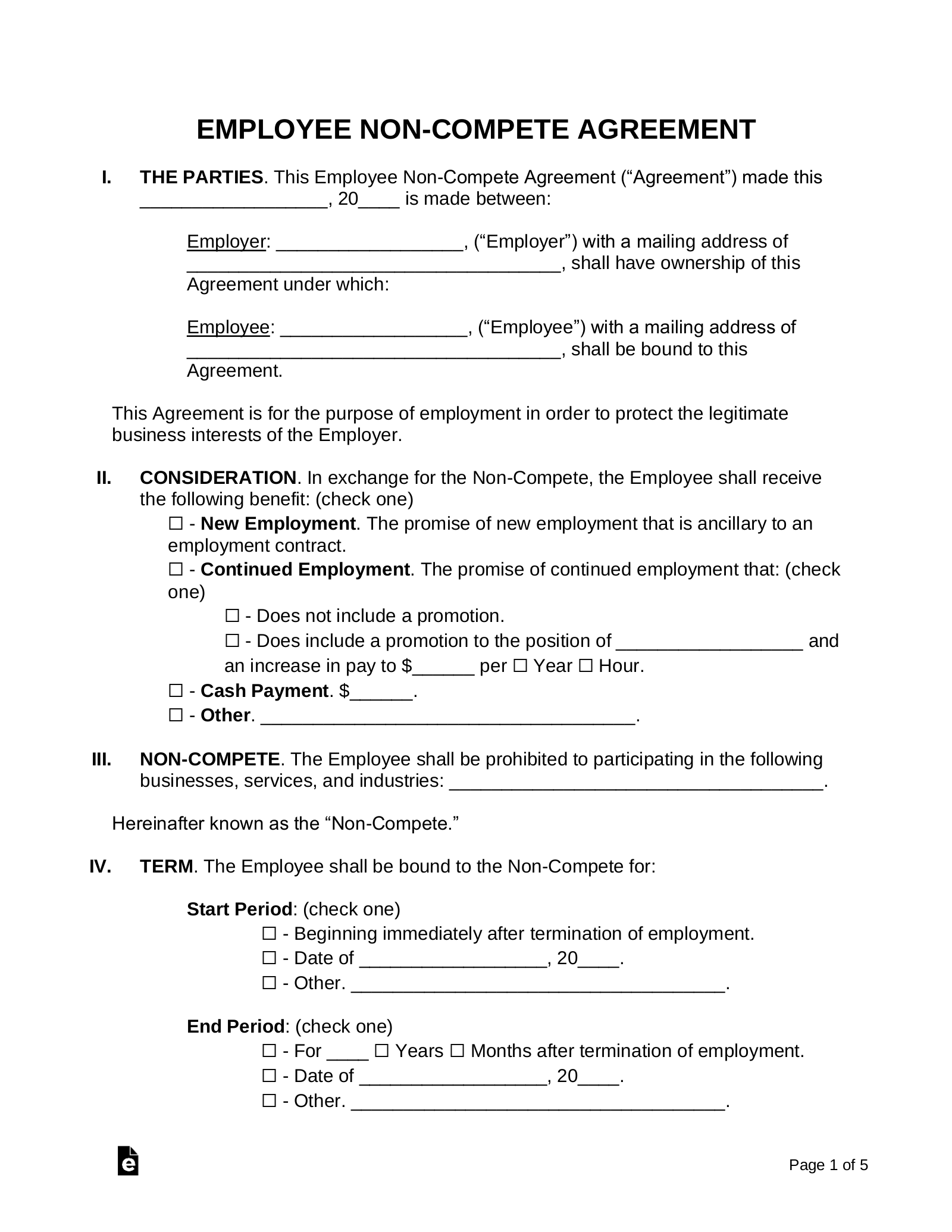Updated February 29, 2024
An employee non-compete agreement is between an employer that restricts an employee’s ability to work in the same industry for a specific geographical area and time period. It must be specific as most States will rule that any broad agreement is unreasonable.
Is it Legal?
An employee non-compete is legal, with limitations, in all 50 States except for California, North Dakota, Oklahoma, and the District of Columbia.
Table of Contents |
By Type (2)
Download: PDF, MS Word, OpenDocument
Download: PDF, MS Word, OpenDocument
Non-Compete Clause
If a non-compete restraint is part of a wide-ranging agreement, such as an employment contract, the following clause may be used:
Non-Compete. During the term of employment, the employee understands that they will be learning proprietary information, including trade secrets, which could be harmful to the legitimate business interests of the employer. Therefore, in order to protect the fiduciary interests of the employer, the employee agrees not to compete with the employer under the following:
- Term. During the duration of employment and for a period of [TERM] after termination.
- Geographical areas. Strictly for the areas of: [JURISDICTION].
- Scope of work. For the specific business or practice of: [SERVICES].
Required when Offering Employment?
Depends on the State. Although, it is recommended at the time of offering employment that a non-compete be mentioned to an employee. Not after the employee has agreed to an offer.
For example, Massachusetts[1] and Oregon[2] have made rules that an employer cannot mention a non-compete after employment has started.
Is Continued Employment treated as Sufficient Consideration?
Depends on State law. Some States require the following:
- Increase in pay;
- Change of title or position; or
- Other employment benefits.
State Laws (table)
How to Write
Download: PDF, MS Word, OpenDocument
I. The Parties
(1) Non-Compete Effective Date. The first calendar date of this document’s effect on the Employer and the Employee should be presented in the First Section. Use the first two lines to document the requested date.
(2) Employer Identity And Mailing Address. Naturally, this paperwork can only act as a safeguard for the Employing Company, if it is attached to the role of “Employer.” Distribute the legal name of the Employer (Hiring Company) where it is requested by Section I.
(3) Mailing Address. On the second available space in the area labeled “Employer,” present the full mailing address where all correspondence and notices regarding this paperwork should be sent when directed to the Employer.
(4) Employee Name. It is imperative that the correct Employee be named as the Signature Party who shall adhere to the non-compete conditions of this agreement. Produce this document’s Signature Employee’s entire name to the line labeled “Employee.”
(5) Mailing Address. In addition to the name of the Employee signing this contract, his or her entire home address should be included to the First Section. Find the second empty line in the “Employee” area then record his or her home address.
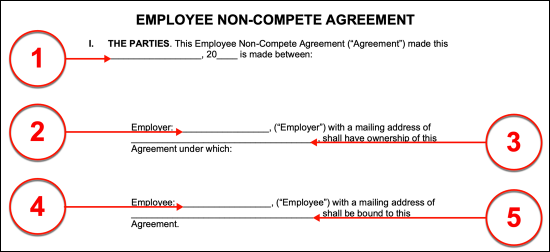
II. Consideration
(6) New Employment. The employment status this contract shall apply to (and/or is contingent upon) must be defined in Section II. For this, one of four choices must be selected. If the position this contract applies to is a new one then, choose the checkbox labeled “New Employment.”

(7) Continued Employment. If this contract shall satisfy or accompany the conditions of an Employee’s “Continued Employment,” then mark the second checkbox statement. Take not that this statement will seek additional information.
(8) Does Not Include Promotion. If this document is being instituted to support an existing position that does not involve the concerned Employee receiving a promotion, then select the first checkbox in the “Continued Employment” statement.
(9) Does Include Promotion. If the position this document applies to includes a promotion, then select the checkbox preceding the phrase “Does Include A Promotion.
(10) Details Of Promotion. In addition to indicating that a promotion will be involved, the title of the position the Employee’s non-compete pledge will support should be documented. Supply the new (additional) pay rate that accompanies the promotion by recording it numerically and indicating if this figure will be paid once a “Year” or once an “Hour” by marking the appropriate checkbox.

(11) Cash Payment. If this non-compete shall cause or accompanies a cash payment to the Employee then, select the “Cash Payment” statement. Also, make sure to use the space attached to the dollar sign in this statement to report the dollar amount that the Employer shall pay the Employee.

(12) Other. If there are any changes to the Employee’s status or one must be established that cannot be defined solely through the previous definitions, then mark the “Other” checkbox. This will require the appropriate details tying the non-compete conditions to changes in the Employee’s standing or pay rate to be produced on the blank line available.

III. Non-Compete
(13) Restricted Industries. The conditions the Employer wishes to impose to prevent the Employee from competing with the Employer must be documented in Section III. It is important to note that all conditions, timelines, and requirements placed on the behavior of the Employee must remain compliant with the laws of the local and state laws governing this agreement. Here, details such as the types of industries or business the Employee may not participate in for the duration of this contract and in the areas that are restricted and what actions are forbidden to the Employee as a result of signing this agreement should be explained to the Employee.
IV. Term
(14) Immediate Start. The term of the conditions this non-compete places upon the Employee must have a definitive start and point of termination. Section IV shall begin this topic by requesting that the start date of this contract be defined. Oftentimes, both Parties prefer that the date when both have signed this paperwork to be the first date of its effect. The first checkbox should be marked to establish the final signature date supplied as the first date of this agreement’s effect. If this document should not become effective immediately upon the signature date of the Employer and Employee (whichever is later) then leave this option unmarked.
(15) Specific Start Date. If the conditions set in this document should only become effective as of a specific date, then select the second “Start Period” option. Also, make sure to furnish the first date when the Employee (and Employer) will be compelled through their signatures to obey the conditions set forth in this paperwork.
(16) Other. If the desired first date of this document’s effect have not been adequately described through the other choices in this section then, select the “Other” checkbox and define precisely how the term of this contract will begin and when the conditions become effective on the blank line in this option.
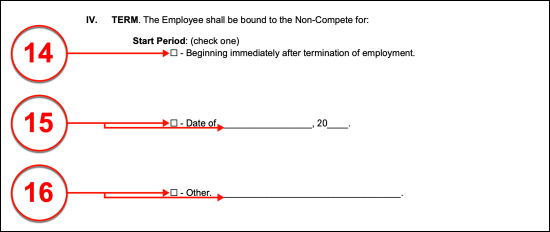
(17) Agreement Life Span. Now that the start of this contract has been defined, its method of termination will need to be established. Since the State where this contract is placed in effect may have specific limitations upon this time, some Employers will prefer to define the term as a count-down beginning with the date of this contract’s effect. If this is the case, then mark the first checkbox in “End Period.” After making this selection, supply the number of years or months that make up this countdown on the blank line provided and select either the “Years” or “Months” checkbox to define this number.
(18) Date Of Termination. If there will be a predefined date when this contract will naturally terminate without any action of the Employer or Employee, then select the second option from “End Period” and produce the calendar date when this paperwork will expire.
(19) Other. If the termination options above do not describe how the non-compete effect of this paperwork will naturally expire, then mark the “Other” checkbox and define the way or the prompting date or action that shall terminate this contract where requested.

V. Geographical Limits
(20) Restricted Areas. A list of every geographical area where the Employee agrees to be restricted from engaging in (any) similar business activity as that of the Employer without the oversight or approval of the Employer must be included with the conditions of this agreement. In most cases, a list of the Counties, Cities, and States where the Employee is restricted will be appropriate however, if needed, neighborhoods may also be listed. Bear in mind that the laws of the State where this document is signed must be complied with when restricting an Employee from practicing a specific trade or business in specific areas.

VI. Non-Solicitation
(21) Employees. This contract can serve to obligate the Employee in refraining from associating with Parties that would directly impact the Employer or circumvent the Employer’s business goals and profit. Section VI delivers a list of the Parties that Employers may wish to restrict Employees signing this agreement from engaging with beginning with other Employees. If the Employer wishes this Signature Employee to agree to being restricted from associating with other Employees, then mark the first checkbox in Section VI.
(22) All Employees Of The Employer. In some cases, the Signature Employee may need to work with a high level of confidentiality. If so, then the Employer may wish to prevent all interactions between the Signature Employee and other Employees. For instance, the Signature Employee may need to perform an impartial audit of the entire Company. If the Employer does not wish the Employee to associate with any other of the Employees in the Company then the first checkbox statement in “Employees” must be selected.
(23) Specific Employees Of The Employer. If the Employer has elected to restrict the Signature Employee from associating with only “Specific Employees Of The Employer” then mark the second checkbox in the “Employees” option. Additionally, a roster composed of the full name of every Employee the Signature Employee will be restricted from engaging with should be produced on the blank line in this statement.
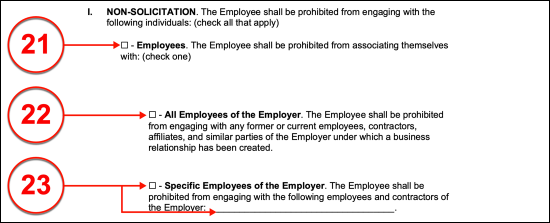
(24) Customers. If the Employer intends to forbid the Signature Employee from participating in any relationships with the Customers of the Employer, then select the second non-solicitation topic from Section VI by marking the checkbox labeled “Customers.”
(25) All Customers Of The Employer. The Signature Employee can agree through this paperwork to refrain from associating with any and all “Customers Of The Employer” by choosing the first statement’s checkbox from the “Customers” option.
(26) Specific Customers Of The Employer. If the Employer wishes to restrict the Signature Employee from contacting, responding to, or otherwise engaging with only “Specific Customers Of The Employer” then select the second statement in the “Customers” option and distribute the identity of each Customer of the Employer that the Signature Employee will agree to be restricted from dealing with in any way.

VII. Purchase Of Release
(27) Cannot Purchase A Release. Occasionally, the Employee may wish to be released from the term of the non-compete conditions he or she agreed to when he or she signed this document in exchange for submitting a payment to the Employer. If the Employer does not intend to release the Employee before this contract’s term is up under any circumstances, then select the first checkbox from Section VII.
(28) Can Purchase A Release. If the Employer would release the Signature Employee prematurely from this agreement in exchange for a specific dollar amount, then select the “Can Purchase A Release” checkbox and distribute the dollar amount that must be paid by the Employee to the Employer for such a release. Note, that once the Employee is released from the conditions of this agreement, the directives imposed by the Employer will no longer be applicable.

IX. Governing Law
(29) State. As mentioned, the State where this contract is signed will determine how, when, and for how long it can be enforced therefore, Section IX provides a space where the name of the State whose laws will apply to be documented. Present the name of this state after the words “State Of” in Section IX.

X. Additional Terms
(30) Additional Information. If the Employer and Employee have agreed to include any provisions that have not been identified thus far by the sections above, then Section X must be used to provide a detailed description of all such provisions or agreements. Some space has been reserved for this task however if needed, more can simply be inserted or additional paperwork may be attached to this document then named here as being considered part of this contract. All attachments made must be permanently affixed to this contract before either the Employer or the Employee signs it.

XI. Entire Agreement
(31) Employee Signature And Name. The only instrument that can bind the Employee to the conditions of this contract for the term it defines will be his or her signature. The Employee should take the time to read every section and every attachment then, upon satisfaction, sign his or her name on the “Employee Signature” line and print his or her name directly below.
(32) Signature Date Of Employee. The calendar date when the Employee submitted his or her signature and name must be recorded by the Employee to complete the signature action.
(33) Employer Signature And Printed Name. Now that the sections above have been completed, the Employer should verify the information produced above. If this paperwork accurately reflects the conditions the Employer wishes imposed, then a Signature Representative of the Employing Company or the Owner of the Company must sign this document and print his or her name where requested.
(34) Date Of Employer Signature. The Signature Representative or Owner of the Employer or Hiring Company should also document the date that he or she submitted his or her signature and name.


